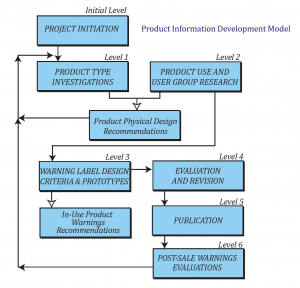Click here to view and/or print a PDF of this technical bulletin, complete with more graphics and example warning labels.
Designing Warning Labels
A number of models and numerous publications have been developed by Dr. Miller and Dr. Lehto to describe an orderly and reasonably rigorous methodology for researching, designing, and testing warnings and other product information. Several of these appear in the books written and edited by current and past Miller Engineering staff. The first model is the “Linear Sequence Determining Warnings Adequacy.” It comes from our first warnings book: Lehto, M.R. and Miller, J.M. (1986). Warnings: Volume 1: Fundamentals, Design and Evaluation Methodologies. Ann Arbor, MI: Fuller Technical Publishing. A second model, which can be chosen, was developed and first presented at a Human Factors & Ergonomics meeting by Dr. Miller and is called “Product Information Development Model.” Lehto, Mark R. & James R. Buck. (2008). Introduction to Human Factors and Ergonomics for Engineers. New York: NY. Lawrence Erlbaum Associates.
ANSI Z535.6 – Product Safety Information Guidelines
The ANSI Z535 Standards series has become a set of systematic guidelines for designing any type of word-based hazard communication, whether signs, labels, tags, tapes, manuals, or instructions. Miller Engineering has been analyzing &creating warning labels according to these standards since their inception in 1998.
The most recent Standard in the series, ANSI Z535.6: “American National Standard for Product Safety Information in Product Manuals, Instructions, and Other Collateral Materials,” was first published in 2006.
Miller Engineering has since developed a protocol for analyzing product information based on ANSI Z535.6, for which numerous review have been done on products ranging from relief valves to pressure washers to self defense products.